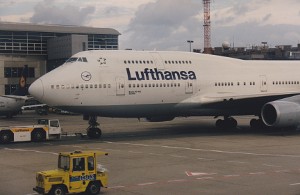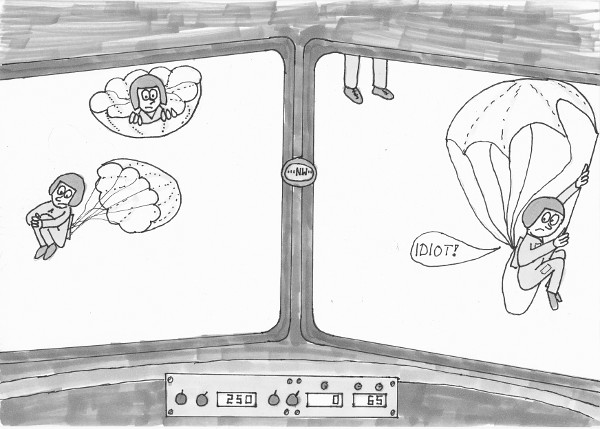
It was sometimes during my first training sessions at Bremen ACC, the enroute area control center responsible for the lower airspace in northern Germany. I had passed one year of theoretical education at the Air Traffic Control School in Munich, at that time located at the old Munich airport of Riem. There all of us newcomers learned the basics of ATC: Rules and Regulations, Navigation, Meteorology, Separation-Basics, Aeronautics and quite a bit of other stuff.
After all that theory we were sent to different control-units, in my case it was Bremen ACC. Here I was put into one of the shift-teams, and assigned to two individuals, my “coaches”. They were to supervise me while doing the first steps on the position, always cutting in when things went wrong.
In Bremen you had to go through training on the coordinator positions first. Training would be complete if you passed a check-out without any flaws, and then you would obtain your licenses for the respective positions and you would be entitled to work on your own without any further supervision by your coaches. Radar training was to follow the coordinator training, but that was some time down the road.
For now I had to understand what coordination meant: Negotiating every detail and data on any flight within your control sector with the next guy, respective the next sector or control unit the flight was to enter, or receiving information from the previous guy upon any changes concerning the flights you were expecting from him. These changes in altitude, variations of expected time over a fix or deviations from the coordinated flight-path were called “revisions”, and I soon learned how important a revision could be.
I was training on one of the “east-sectors” of Bremen ACC. It comprised a bunch of airspace north of Hannover, up to and including the area of Hamburg. This sector was bordered by other sectors of Bremen-ACC to the south, west and north. Underneath were the approach areas of Hannover and Hamburg airports, above the upper airspace controlled by Maastricht UAC. To the east lay the border with eastern Germany, a border no one was supposed to cross.
The only exception to this were the 3 corridors, of which we controlled the entry point to the northern corridor. This entry point was BKD (Brünkendorf) VOR/DME.
The coordination partner for the northern corridor through eastern Germany was Air Safety Center in West-Berlin, a joint control center run by the allied forces. With them we had to follow all the same procedures as with everyone else. In the corridors flights were only accepted up to 10 000 feet altitude. In the northern corridor it was common practice to fly odd levels plus 500 feet eastbound, even levels plus 500 feet westbound. So a flight from Berlin would enter our area at FL 85 (8500 feet) or at FL 65, lower levels were normally not flown in the corridor.
We were expecting a Pan Am 727 from Berlin on its way to Hamburg, estimated some time over BKD at FL 85. As with all other partners, if there were any deviation in time and/or altitude from that estimate, Berlin Air Safety Center would give us a revision.
At the same time, Lüneburg airport (some miles northwest from BKD) was conducting parachute jump training, that is students jumping out of small planes with their chutes opening automatically once they left the plane. Those planes needed a clearance from Bremen ACC to drop their students, and they obtained the clearance from the responsible sector, our sector. And the individual issuing this clearance was, by telephone – me!
We (as others also) called this para-dropping circus “Deppenwerfen”, that means “idiot warping”! When the call from Lüneburg reached my position, I wasn’t sure what to do. My coach patiently told me “… now look around, do you have any other traffic which could conflict with the dropping? No! And what altitude they want to drop their students from? Fl 70. And in what altitude are we expecting the clipper 727? FL 85. So???? – Go ahead and tell them idiots “Cleared to warp!” So I did.
We could see the para-dropping plane on our radar, and we also saw the approaching Clipper, but only his symbol, since at that time we didn’t have universal transponder settings. After the clipper would call in on our frequency, we would assign him one of our own transponder codes and thereafter have him positively identified with call-sign and his altitude on the screen. The Lüneburg plane showed a steady FL 70 on the scope.
Soon the frequency crackled alive with a harsh voice “Bremen, this is Clipper 123 at FL 65 – – What the hell is all that crap in front of my windshield?!” Our hearts stopped!
What happened? Apparently the Clipper came in a different altitude than the one we expected him to come. And the poor students, after they had been warped out of their plane and their chutes automatically opened, they all over sudden were encountered by this enormous Boeing 727 rushing through their cloud of parachutes. The poor guys were literally trying to climb up the yarns by which they were hanging from their chutes to get out of the way!
Soon there was yelling all around us. My coach yelled, the neighbor positions yelled, the watch-supervisor yelled, the Clipper captain yelled, and the phone was ringing angrily, and after answering it someone else yelled. But – after a few minutes it turned out nobody was harmed, except excessive adrenalin within the 727 crew, the poor students, my coach and me. Phew!
After everything calmed down, came the investigation. It turned out that Air Safety Center in Berlin had simply – forgotten to pass the level revision! Clipper 123 had turbulence at FL 85 and still within Berlin’s airspace had wanted to descend to FL 65, which he had been allowed. Finally my coach told me: “See, how important a proper revision is!” So I learned …

